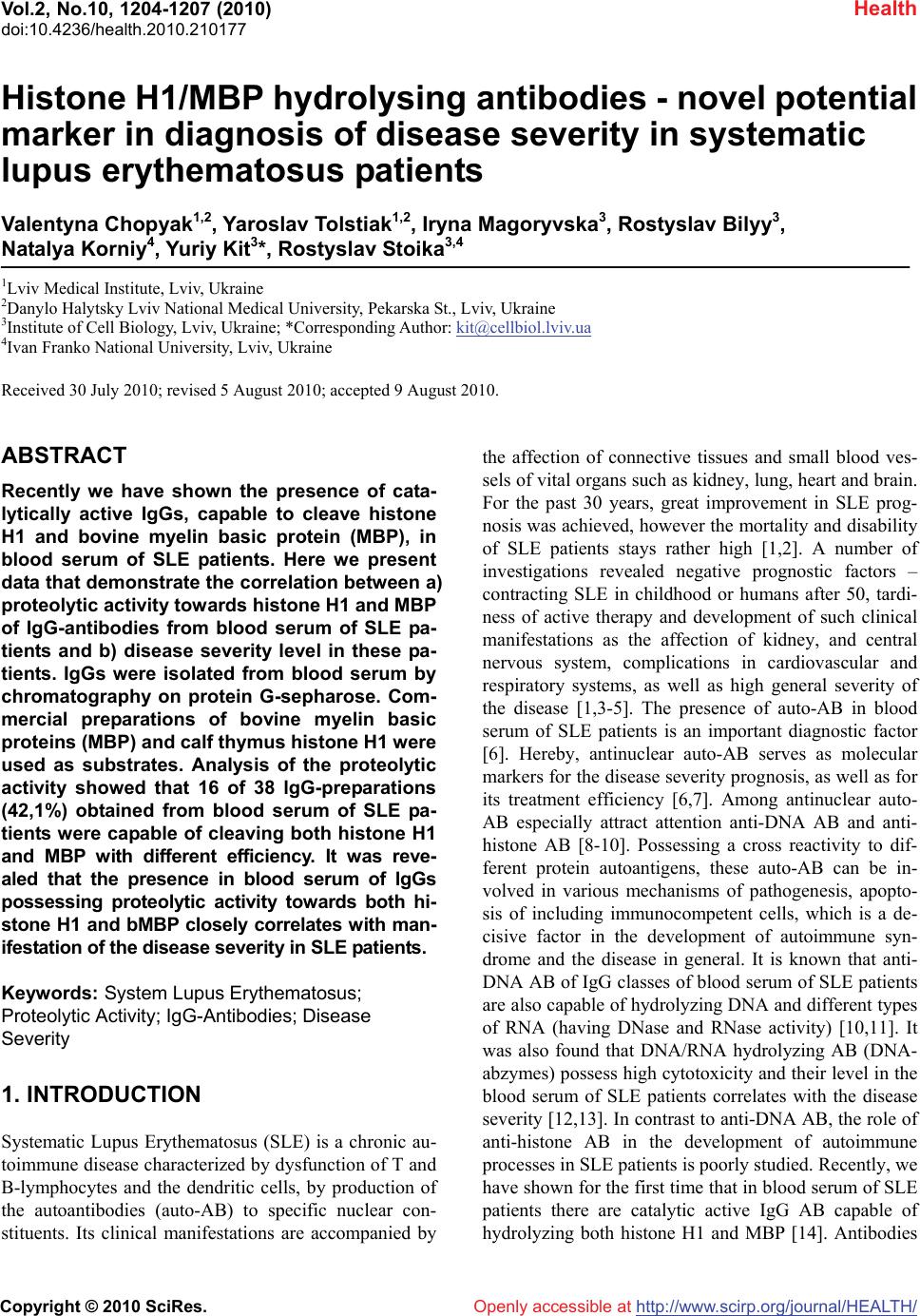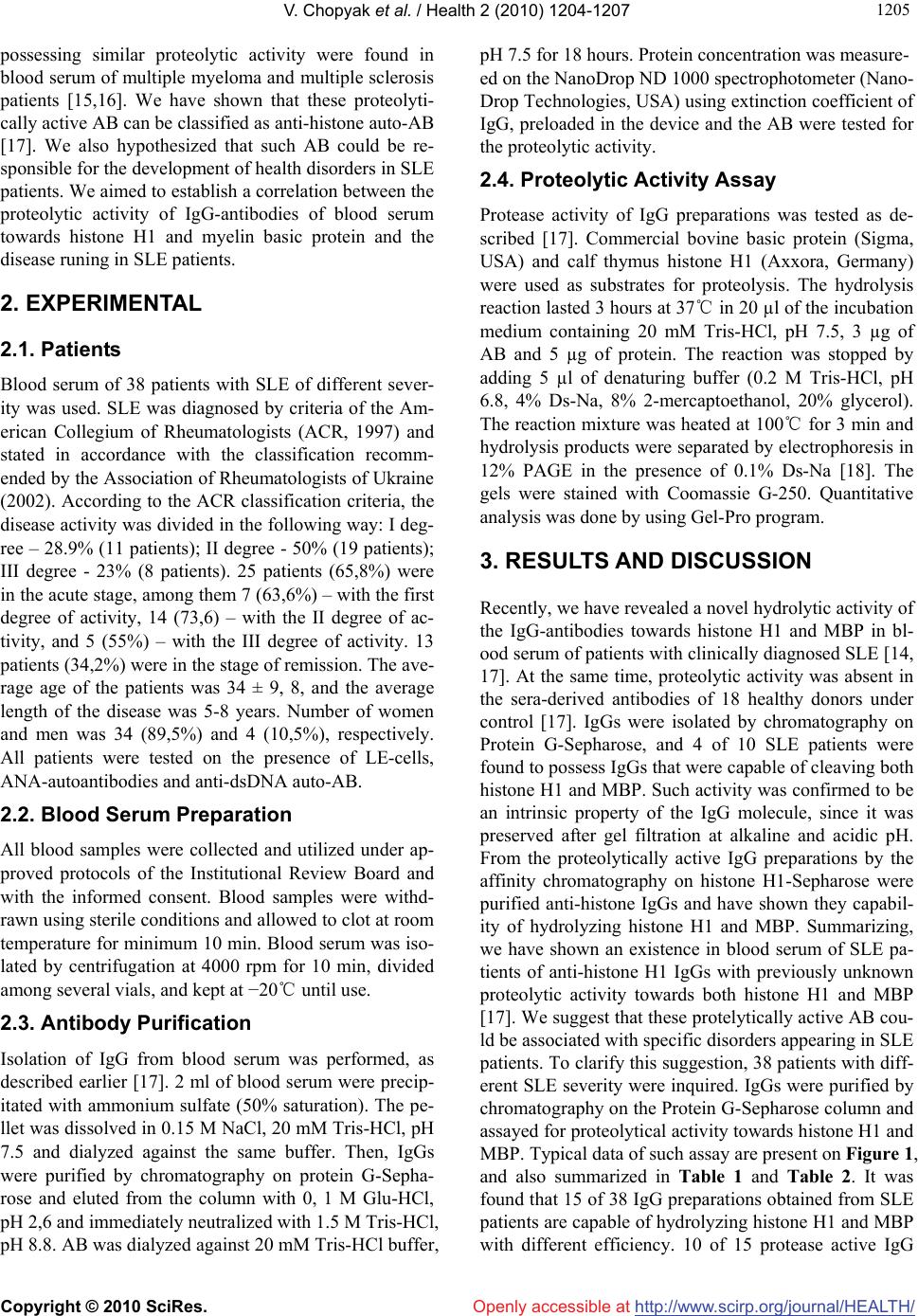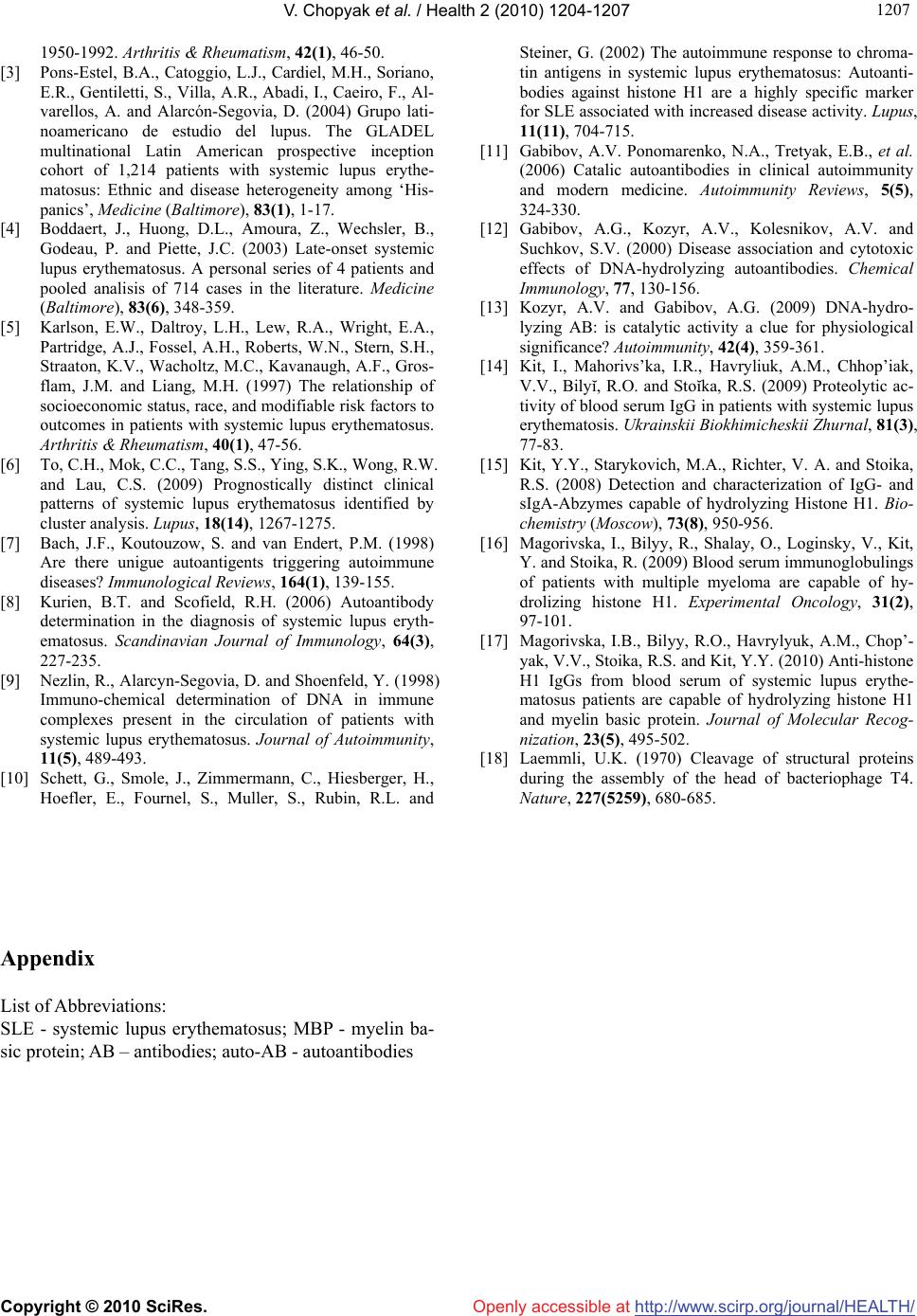Paper Menu >>
Journal Menu >>
 Vol.2, No.10, 1204-1207 (2010) Health doi:10.4236/health.2010.210177 Copyright © 2010 SciRes. Openly accessible at http://www.scirp.org/journal/HEALTH/ Histone H1/MBP hydrolysing antibodies - novel potential marker in diagnosis of disease severity in systematic lupus erythematosus patients Valentyna Chopyak1,2, Yaroslav Tolstiak1,2, Iryna Magoryvska3, Rostyslav Bilyy3, Natalya Korniy4, Yuriy Kit3*, Rostyslav Stoika3,4 1Lviv Medical Institute, Lviv, Ukraine 2Danylo Halytsky Lviv National Medical University, Pekarska St., Lviv, Ukraine 3Institute of Cell Biology, Lviv, Ukraine; *Corresponding Author: kit@cellbiol.lviv.ua 4Ivan Franko National University, Lviv, Ukraine Received 30 July 2010; revised 5 August 2010; accepted 9 August 2010. ABSTRACT Recently we have shown the presence of cata- lytically active IgGs, capable to cleave histone H1 and bovine myelin basic protein (MBP), in blood serum of SLE patients. Here we present data that demonstrate the correlation between a) proteolytic activity towards histone H1 and MBP of IgG-antibodies from blood serum of SLE pa- tients and b) disease severity level in these pa- tients. IgGs were isolated from blood serum by chromatography on protein G-sepharose. Com- mercial preparations of bovine myelin basic proteins (MBP) and calf thymus histone H1 were used as substrates. Analysis of the proteolytic activity showed that 16 of 38 lgG-preparations (42,1%) obtained from blood serum of SLE pa- tients were capable of cleaving both histone H1 and MBP with different efficiency. It was reve- aled that the presence in blood serum of lgGs possessing proteolytic activity towards both hi- stone H1 and bMBP closely correlates with man- ifestation of the disease severity in SLE patients. Keywords: System Lupus Erythematosus; Proteolytic Activity; IgG-Antibodies; Disease Severity 1. INTRODUCTION Systematic Lupus Erythematosus (SLE) is a chronic au- toimmune disease characterized by dysfunction of T and B-lymphocytes and the dendritic cells, by production of the autoantibodies (auto-AB) to specific nuclear con- stituents. Its clinical manifestations are accompanied by the affection of connective tissues and small blood ves- sels of vital organs such as kidney, lung, heart and brain. For the past 30 years, great improvement in SLE prog- nosis was achieved, however the mortality and disability of SLE patients stays rather high [1,2]. A number of investigations revealed negative prognostic factors – contracting SLE in childhood or humans after 50, tardi- ness of active therapy and development of such clinical manifestations as the affection of kidney, and central nervous system, complications in cardiovascular and respiratory systems, as well as high general severity of the disease [1,3-5]. The presence of auto-AB in blood serum of SLE patients is an important diagnostic factor [6]. Hereby, antinuclear auto-AB serves as molecular markers for the disease severity prognosis, as well as for its treatment efficiency [6,7]. Among antinuclear auto- AB especially attract attention anti-DNA AB and anti- histone AB [8-10]. Possessing a cross reactivity to dif- ferent protein autoantigens, these auto-AB can be in- volved in various mechanisms of pathogenesis, apopto- sis of including immunocompetent cells, which is a de- cisive factor in the development of autoimmune syn- drome and the disease in general. It is known that anti- DNA AB of IgG classes of blood serum of SLE patients are also capable of hydrolyzing DNA and different types of RNA (having DNase and RNase activity) [10,11]. It was also found that DNA/RNA hydrolyzing AB (DNA- abzymes) possess high cytotoxicity and their level in the blood serum of SLE patients correlates with the disease severity [12,13]. In contrast to anti-DNA AB, the role of anti-histone AB in the development of autoimmune processes in SLE patients is poorly studied. Recently, we have shown for the first time that in blood serum of SLE patients there are catalytic active IgG AB capable of hydrolyzing both histone H1 and MBP [14]. Antibodies  V. Chopyak et al. / Health 2 (2010) 1204-1207 Copyright © 2010 SciRes. Openly accessible at http://www.scirp.org/journal/HEALTH/ 120 1205 possessing similar proteolytic activity were found in blood serum of multiple myeloma and multiple sclerosis patients [15,16]. We have shown that these proteolyti- cally active AB can be classified as anti-histone auto-AB [17]. We also hypothesized that such AB could be re- sponsible for the development of health disorders in SLE patients. We aimed to establish a correlation between the proteolytic activity of IgG-antibodies of blood serum towards histone H1 and myelin basic protein and the disease runing in SLE patients. 2. EXPERIMENTAL 2.1. Patients Blood serum of 38 patients with SLE of different sever- ity was used. SLE was diagnosed by criteria of the Am- erican Collegium of Rheumatologists (ACR, 1997) and stated in accordance with the classification recomm- ended by the Association of Rheumatologists of Ukraine (2002). According to the ACR classification criteria, the disease activity was divided in the following way: I deg- ree – 28.9% (11 patients); II degree - 50% (19 patients); III degree - 23% (8 patients). 25 patients (65,8%) were in the acute stage, among them 7 (63,6%) – with the first degree of activity, 14 (73,6) – with the II degree of ac- tivity, and 5 (55%) – with the III degree of activity. 13 patients (34,2%) were in the stage of remission. The ave- rage age of the patients was 34 ± 9, 8, and the average length of the disease was 5-8 years. Number of women and men was 34 (89,5%) and 4 (10,5%), respectively. All patients were tested on the presence of LE-cells, ANA-autoantibodies and anti-dsDNA auto-AB. 2.2. Blood Serum Preparation All blood samples were collected and utilized under ap- proved protocols of the Institutional Review Board and with the informed consent. Blood samples were withd- rawn using sterile conditions and allowed to clot at room temperature for minimum 10 min. Blood serum was iso- lated by centrifugation at 4000 rpm for 10 min, divided among several vials, and kept at −20℃ until use. 2.3. Antibody Purification Isolation of IgG from blood serum was performed, as described earlier [17]. 2 ml of blood serum were precip- itated with ammonium sulfate (50% saturation). The pe- llet was dissolved in 0.15 M NaCl, 20 mM Tris-HCl, pH 7.5 and dialyzed against the same buffer. Then, IgGs were purified by chromatography on protein G-Sepha- rose and eluted from the column with 0, 1 M Glu-HCl, pH 2,6 and immediately neutralized with 1.5 M Tris-HCl, pH 8.8. AB was dialyzed against 20 mM Tris-HCl buffer, pH 7.5 for 18 hours. Protein concentration was measure- ed on the NanoDrop ND 1000 spectrophotometer (Nano- Drop Technologies, USA) using extinction coefficient of IgG, preloaded in the device and the AB were tested for the proteolytic activity. 2.4. Proteolytic Activity Assay Protease activity of IgG preparations was tested as de- scribed [17]. Commercial bovine basic protein (Sigma, USA) and calf thymus histone H1 (Axxora, Germany) were used as substrates for proteolysis. The hydrolysis reaction lasted 3 hours at 37℃ in 20 µl of the incubation medium containing 20 mM Tris-HCl, pH 7.5, 3 µg of AB and 5 µg of protein. The reaction was stopped by adding 5 µl of denaturing buffer (0.2 M Tris-HCl, pH 6.8, 4% Ds-Na, 8% 2-mercaptoethanol, 20% glycerol). The reaction mixture was heated at 100℃ for 3 min and hydrolysis products were separated by electrophoresis in 12% PAGE in the presence of 0.1% Ds-Na [18]. The gels were stained with Coomassie G-250. Quantitative analysis was done by using Gel-Pro program. 3. RESULTS AND DISCUSSION Recently, we have revealed a novel hydrolytic activity of the IgG-antibodies towards histone H1 and MBP in bl- ood serum of patients with clinically diagnosed SLE [14, 17]. At the same time, proteolytic activity was absent in the sera-derived antibodies of 18 healthy donors under control [17]. IgGs were isolated by chromatography on Protein G-Sepharose, and 4 of 10 SLE patients were found to possess IgGs that were capable of cleaving both histone H1 and MBP. Such activity was confirmed to be an intrinsic property of the IgG molecule, since it was preserved after gel filtration at alkaline and acidic pH. From the proteolytically active IgG preparations by the affinity chromatography on histone H1-Sepharose were purified anti-histone IgGs and have shown they capabil- ity of hydrolyzing histone H1 and MBP. Summarizing, we have shown an existence in blood serum of SLE pa- tients of anti-histone H1 IgGs with previously unknown proteolytic activity towards both histone H1 and MBP [17]. We suggest that these protelytically active AB cou- ld be associated with specific disorders appearing in SLE patients. To clarify this suggestion, 38 patients with diff- erent SLE severity were inquired. IgGs were purified by chromatography on the Protein G-Sepharose column and assayed for proteolytical activity towards histone H1 and MBP. Typical data of such assay are present on Figure 1, and also summarized in Table 1 and Table 2. It was found that 15 of 38 IgG preparations obtained from SLE patients are capable of hydrolyzing histone H1 and MBP with different efficiency. 10 of 15 protease active IgG  V. Chopyak et al. / Health 2 (2010) 1204-1207 Copyright © 2010 SciRes. Openly accessible at http://www.scirp.org/journal/HEALTH/ 1206 Figure 1. Proteolytic activity of polyclonal IgGs preparations, purified by chromatography on Protein G-sepharose from blo- od serum of SLE patients. Lines 1-4 – IgG preparations incu- bated with histone H1; Lines 1’-4’ – IgGs preparations incu- bated with bMBP. C-histone H1 before incubation with IgGs (control). C’ – bMBP before incubation with IgGs (control). Position of heavy (H) and light (L) chains of IgG, and also position of histone H1 (his H1) and bovine myeline basic pro- tein (bMBP) are shown by arrows. M - protein molecular mass markers (17, 34, 43, 55, 72, 95, 130, 170 kDa, respectively). Table 1. Demographical and clinical characteristics of SLE pa- tients. Parameters М ± SD Proteolytical activity of IgG Gender: Woman: Men: 34 (89.5%) 4 (10.5%) H(3);M(1);HM(10 ) H(0); M(1); HM(0) Disease activity: І degree ІІ degree ІІІ degree 11 (28,9%) 19 (50%) 8 (21.1%) H(3);M(1);HM(1) H(1); M(0);HM(7) H(0); M(0);HM(2) Clinical features: Joints affection (arthralgia) Skin affection (erythema “butterfly”) nervous system affection: а) headache б) epileptic seizures в) sleep disturbance 26 (68.4%) 23 (60.5 %) 12 (31.5%) 1 (0.026%) 4 (10.5%) H(3);M(2); HM(9) H(3); M(2); HM(6) H(0);M(0);HM(6) H(0);M(0);HM(0) H(0);M(0);HM(5) Heart affection (carditis) 4 (10.5% ) H(0);M(0);HM(5) Nephritis 15 (39.4%) H(0);M(2);HM(7) Active Epstein-Barr viruses infection 5 (13.1%) H(0);M(0);HM(2) Body temperature increase 19 (50%) H(2);M(0);HM(9) H, M, HM - proteolytic activity of IgGs towards histone H1, myelin basic protein, and both histone H1 and myelin basic protein, respectively. In brac- kets are shown a number of patients. Table 2. Correlation between disease severities and proteolytic activity of IgGs. Disease activity Stage of disease Histone Н1/MBP – hydrolyzing activity І Acute 7 (63.3%) Remission 4 (36.7%) 4 (57.1%) 1 (25%) ІІ Acute 14 (73.6%) Remission 5 (26.4%) 8 (57.1%) 0 ІІІ Acute 4 (50%) Remission 4 (50%) 2 (50%) 0 preparations hydrolyzed both histone H1 and MBP, 3 preparations were capable of cleaving only histone H1 and 2 of them – only MBP. Protease activity assay rev- ealed that AB of 3 of 10 patients with diagnosed SLE disease for the first time was capable of cleaving only histone H1. None of 10 seropositive (ANA + dsDNA +) systematically treated SLE patients for year possessed of IgG with catalytical activity. Among 25 patients in acute stage of the disease, 2 showed a hydrolysing activity on- ly towards histone H1; 1 patient (age 23) possessed a low activity towards MBP, and IgGs of 12 patients were capable of effectively cleaving both proteins. IgG pre- paration purified from blood serum of 6 patients with nervous system affection (headache or sleep disturbance) showed high catalytic activity towards both histone H1 and MBP proteins. Among 6 children of the puberty pe- riod (age 13-16) suffering from SLE, 4 were in the acute stage and contained IgG-antibodies capable of hydro- lyzing both histone H1 and MBP. The catalytic activity was not observed in 12 patients in the remission stage as well as in 3 patients with other systematic disoders (an- kylosing spondylitis, systemic vasculitis, mixed disorder of the conjuctive tissue). 4. CONCLUSIONS Appearance of proteolytic activity of IgG in blood serum of SLE patients towards both histone H1 and myelin basic protein tightly correlates with the disease severity in these patients. REFERENCES [1] Cervera, R., Khamashta, M.A., Font, J., Sebastiani, G.D., Gil, A., Lavilla, P., Mejía, J.C., Aydintug, A.O., Chwa- linska-Sadowska, H., de Ramón, E., Fernández-Nebro, A., Galeazzi, M., Valen, M., Mathieu, A., Houssiau, F., Caro, N., Alba, P., Ramos-Casals, M., Ingelmo, M. and Hughes, G.R. (2003) European working party on sys- temic lupus erythematosus. Morbidity and mortality in systemic lupus erythematosus during a 10-year period. A comparison of early and late matifestation in a cohort of 1, 000 patients. Medicine (Baltimore), 82(5), 299-308. [2] Uramoto, K.M., Michet, C.J., Thumboo, J. Sunku, J., O’Fallon, W.N. and Gabriel, S.E. (1999) Trends in the incidence and mortality of systemic lupus erytemathosus,  V. Chopyak et al. / Health 2 (2010) 1204-1207 Copyright © 2010 SciRes. Openly accessible at http://www.scirp.org/journal/HEALTH/ 120 1207 1950-1992. Arthritis & Rheumatism, 42(1), 46-50. [3] Pons-Estel, B.A., Catoggio, L.J., Cardiel, M.H., Soriano, E.R., Gentiletti, S., Villa, A.R., Abadi, I., Caeiro, F., Al- varellos, A. and Alarcón-Segovia, D. (2004) Grupo lati- noamericano de estudio del lupus. The GLADEL multinational Latin American prospective inception cohort of 1,214 patients with systemic lupus erythe- matosus: Ethnic and disease heterogeneity among ‘His- panics’, Medicine (Baltimore), 83(1), 1-17. [4] Boddaert, J., Huong, D.L., Amoura, Z., Wechsler, B., Godeau, P. and Piette, J.C. (2003) Late-onset systemic lupus erythematosus. A personal series of 4 patients and pooled analisis of 714 cases in the literature. Medicine (Baltimore), 83(6), 348-359. [5] Karlson, E.W., Daltroy, L.H., Lew, R.A., Wright, E.A., Partridge, A.J., Fossel, A.H., Roberts, W.N., Stern, S.H., Straaton, K.V., Wacholtz, M.C., Kavanaugh, A.F., Gros- flam, J.M. and Liang, M.H. (1997) The relationship of socioeconomic status, race, and modifiable risk factors to outcomes in patients with systemic lupus erythematosus. Arthritis & Rheumatism, 40(1), 47-56. [6] To, C.H., Mok, C.C., Tang, S.S., Ying, S.K., Wong, R.W. and Lau, C.S. (2009) Prognostically distinct clinical patterns of systemic lupus erythematosus identified by cluster analysis. Lupus, 18(14), 1267-1275. [7] Bach, J.F., Koutouzow, S. and van Endert, P.M. (1998) Are there unigue autoantigents triggering autoimmune diseases? Immunological Reviews, 164(1), 139-155. [8] Kurien, B.T. and Scofield, R.H. (2006) Autoantibody determination in the diagnosis of systemic lupus eryth- ematosus. Scandinavian Journal of Immunology, 64(3), 227-235. [9] Nezlin, R., Alarcyn-Segovia, D. and Shoenfeld, Y. (1998) Immuno-chemical determination of DNA in immune complexes present in the circulation of patients with systemic lupus erythematosus. Journal of Autoimmunity, 11(5), 489-493. [10] Schett, G., Smole, J., Zimmermann, C., Hiesberger, H., Hoefler, E., Fournel, S., Muller, S., Rubin, R.L. and Steiner, G. (2002) The autoimmune response to chroma- tin antigens in systemic lupus erythematosus: Autoanti- bodies against histone Н1 are a highly specific marker for SLE associated with increased disease activity. Lupus, 11(11), 704-715. [11] Gabibov, A.V. Ponomarenko, N.A., Tretyak, E.B., et al. (2006) Catalic autoantibodies in clinical autoimmunity and modern medicine. Autoimmunity Reviews, 5(5), 324-330. [12] Gabibov, A.G., Kozyr, A.V., Kolesnikov, A.V. and Suchkov, S.V. (2000) Disease association and cytotoxic effects of DNA-hydrolyzing autoantibodies. Chemical Immunology, 77, 130-156. [13] Kozyr, A.V. and Gabibov, A.G. (2009) DNA-hydro- lyzing AB: is catalytic activity a clue for physiological significance? Autoimmunity, 42(4), 359-361. [14] Kit, I., Mahorivs’ka, I.R., Havryliuk, A.M., Chhop’iak, V.V., Bilyĭ, R.O. and Stoĭka, R.S. (2009) Proteolytic ac- tivity of blood serum IgG in patients with systemic lupus erythematosis. Ukrainskii Biokhimicheskii Zhurnal, 81(3), 77-83. [15] Kit, Y.Y., Starykovich, M.A., Richter, V. A. and Stoika, R.S. (2008) Detection and characterization of IgG- and sIgA-Abzymes capable of hydrolyzing Histone H1. Bio- chemistry (Moscow), 73(8), 950-956. [16] Magorivska, I., Bilyy, R., Shalay, O., Loginsky, V., Kit, Y. and Stoika, R. (2009) Blood serum immunoglobulings of patients with multiple myeloma are capable of hy- drolizing histone H1. Experimental Oncology, 31(2), 97-101. [17] Magorivska, I.B., Bilyy, R.O., Havrylyuk, A.M., Chop’- yak, V.V., Stoika, R.S. and Kit, Y.Y. (2010) Anti-histone H1 IgGs from blood serum of systemic lupus erythe- matosus patients are capable of hydrolyzing histone H1 and myelin basic protein. Journal of Molecular Recog- nization, 23(5), 495-502. [18] Laemmli, U.K. (1970) Cleavage of structural proteins during the assembly of the head of bacteriophage T4. Nature, 227(5259), 680-685. Appendix List of Abbreviations: SLE - systemic lupus erythematosus; MBP - myelin ba- sic protein; AB – antibodies; auto-AB - autoantibodies |

